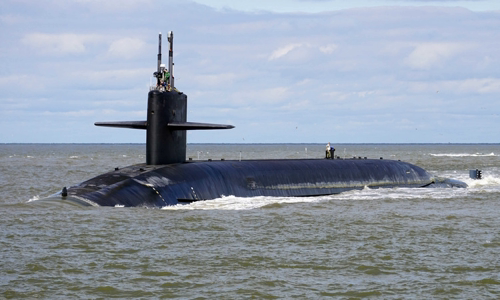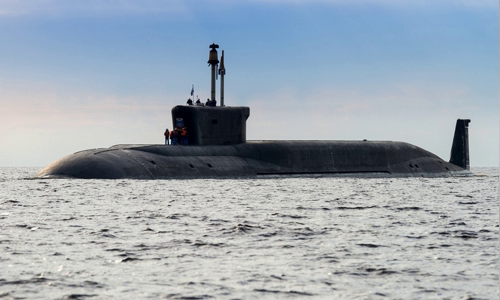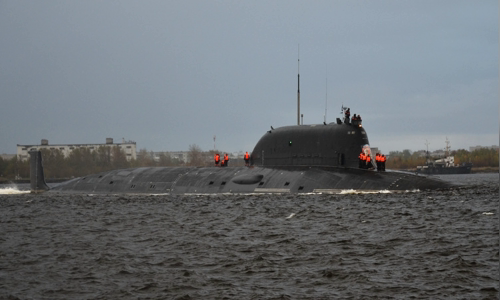Russia and the United States are staffing many strategic nuclear submarines capable of carrying enough warheads to destroy the world.
Strategic submarines are one of the most powerful deterrent weapons in the competition between great powers. This prompted Russia and the US to develop a variety of submarines equipped with nuclear arsenals capable of destroying the world in just half an hour.

The Ohio-based USS Alaska submarine returned to port in early 2019 Photo: US Navy
The United States began building Ohio-class ballistic missile submarines to deter the Soviet Union in the late 1970s. A total of 18 of the 24 ships were built between 1976 and 1997, each with equivalent value. nearly 3 billion USD now.
With a displacement of 18,750 tons when diving and a length of 175 meters, the Ohio class is the largest submarine model in US Navy history. Each vessel can carry 24 submarine-launched ballistic missiles (SLBMs) UGM-133 Trident II D5 with a range of 11,300 km. Each missile can carry a maximum of 12 nuclear warheads with a total explosive power equivalent to 5.7 million tons of TNT.
After the end of the Cold War, the United States decided to convert four Ohio-class submarines, dismantling Trident ballistic missiles and equipping them with Tomahawk ground attack cruise missiles. Each converted submarine carried 154 Tomahawks in 22 launch tubes, more than a fleet of surface ships. All of these missiles can be launched in series from underwater within 6 minutes.
Ships equipped with Tomahawk missiles are capable of performing a variety of tasks. Two rocket-free launchers were converted into special open doors, allowing the deployment of more than 60 naval special forces. They are also used to launch unmanned submersibles (UUVs), special submarines, hydro sonic buoys and other types of underwater sensors.
The Joint Nuclear Status Assessment (NPR), released in the Pentagon in 2010, shows that the U.S. Navy maintains 12 Ohio ships at sea patrol, while the two are put into routine maintenance.
The Ohio class has many powerful features but is becoming obsolete, the first ones are about to expire. That forced the US Navy to develop a Columbia-class super submarine instead.
The Columbia-class submarine is 170 meters long and has a displacement of nearly 21,000 tons, designed with stealth features and many modern technologies of the 21st century. The new generation Columbia reactor allows the ship to operate with higher frequency and no need to refuel for longer periods.

Yury Dolgorukiy submarine under Project 955 Photo: Oleg Kuleshov
Each Columbia-class submarine is equipped with 16 Trident D5 ballistic missiles, 8 less than the Ohio class. The US plans to build 12 Columbia-class submarines at a total cost of nearly $ 350 billion, the first of which will be built in 2021, put on service in 2031 and operated for a minimum of 42 years.
However, the US Government Audit Office (GAO) in late 2017 warned that this project could go into the footsteps of F-35 super fighters and Ford-class aircraft carriers due to the application of too many new technologies. and unproven, making development time and manufacturing costs far exceed expectations.
Russia is also not inferior to constantly launching new submarines, while upgrading Soviet-era ones to ensure the ability to deter opponents.
The 955 Borei nuclear submarine was researched, developed and handed over to the Russian Army in 2013 by the Rubin Design Institute. The ship is 170 m long, 13.5 m wide and has a displacement of 24,000 tons and speed. maximum diving time reaches 56 km / h and unlimited range.
The main weapon of the Borei class is 16 RSM-56 Bulava ballistic missiles with a range of over 9,000 km. Each Bulava rocket can carry 10 nuclear warheads with the power equivalent to 1.5 million tons of TNT. The rocket is compact in size, possesses high flight speed and maneuverability, surpassing many modern ballistic missile shields today.
After three aircraft using the original design, Russia began to play the 995A Borei-A variant in 2012 with significant improvements in communication systems, reduced noise levels and increased living space for sailors. group. The Russian Ministry of Defense plans to have at least eight Borei-class submarines, including three original aircraft and five Borei-A ships.
The backbone of the current Russian strategic submarine fleet is still 6 submarines Project 666BDRM Delfin was built during 1981-1992. Each vessel is about 166 meters long and has a displacement of more than 18,000 tons.

The Yasen-M Kazan submarine went to sea at the end of 2018 Photo: Oleg Kuleshov
The main weapon of the Delfin class is 16 R-29RMU Sineva ballistic missiles. Each fruit can carry a maximum of 8 nuclear warheads with a total explosive capacity equivalent to 2 million tons of TNT. The missile reaches a range of 8,300 km at maximum load, or 11,550 km if the number of warheads is reduced.
The submarine can dive as deep as 400 m and launch all missiles at a depth of 55 m while moving, allowing it to hide and unleash a surprise attack that makes it difficult for the opponent to cope with.
In addition to the two strategic submarines above, the Russian Navy also possesses a very dangerous weapon, the versatile attack submarine Project 855 Yasen. According to military expert Dave Majumdar, Yasen is not a traditional strategic nuclear submarine, but a Kalibr cruise missile complex with 40 3M-14K shells reaching its range of over 2,500 km is enough to threaten US territory. .
Yasen-class submarines and the Yasen-M comprehensive upgrade have a displacement of 13,800 tons, can operate at a depth of 520 m, a diving speed of 57 km / h, a crew of 64 people and can operate. active for 100 consecutive days.
Russia launched 3 aircraft, the first of which was named Severodvinsk under the original Project 855, the remaining ships all applied the design in Project 855M "Yasen-M". They have high speed and very low noise, can easily reach the east coast of the United States and attack targets located deep in the country.
Not only Russian experts, Western analysts and many US senior officers also think that Yasen and Yasen-M class submarines are the most formidable opponents of the US Navy. Rear Admiral Dave Johnson, a former officer at the US Naval Systems Command (NAVSEA), said he was so impressed with the Russian submarine that he built a model of the Severodvinsk outside his office.



 MeeshaEaston
MeeshaEaston







